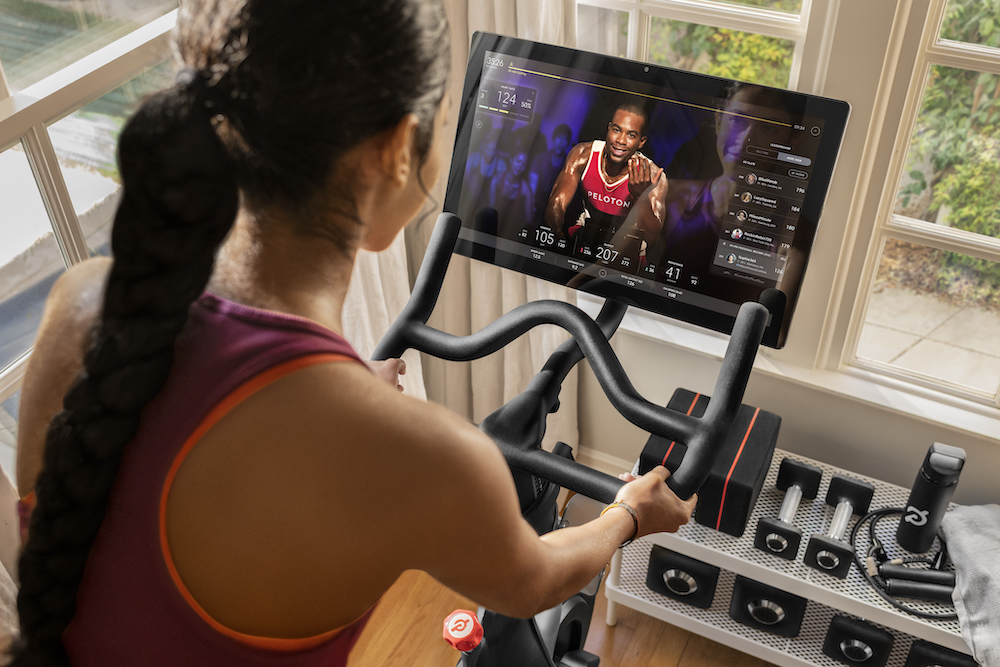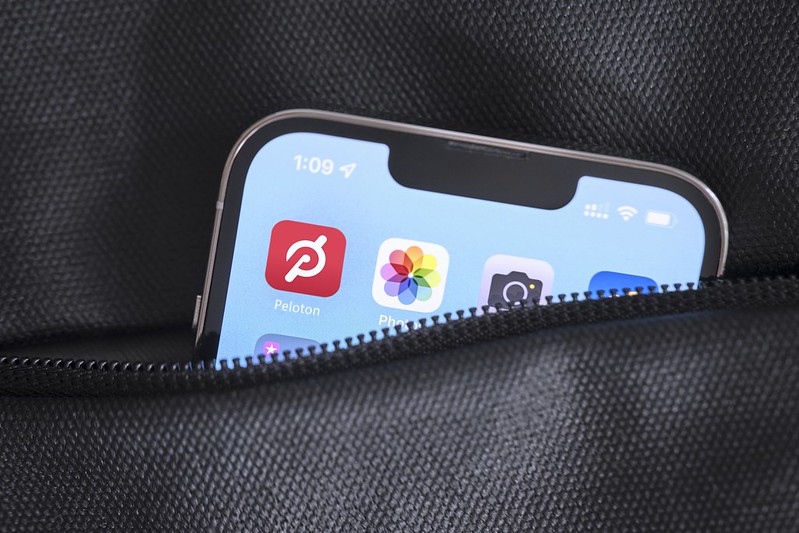Peloton bikes are sweeping the nation and quickly becoming one of the most popular options around.
They’re high-quality spin bikes that are just as good as the ones you’d find at your local spin studio, allowing you to get an intense workout at home.
For a monthly fee, you can connect your bike to the Peloton app. It has live, on-demand classes led by top-notch instructors who will help motivate you to push yourself — it’s a lot like taking a real spin class at home!
In addition to spin classes, you’ll be able to access bootcamps, yoga classes, strength training workouts, and more.
Peloton is fun, popular, and convenient — but will Peloton get you in shape? What kind of results can you expect to see from regularly workout out with your Peloton?

Here are some of the benefits of regular Peloton spin workouts you can expect to see after just a few months or 80 days or so:
- Better mood thanks to endorphins
- Ten to fifteen pounds of weight loss
- Toned, athletic leg muscles
- A stronger core
- Better cardiovascular and muscular endurance
I spoke with a few fitness experts to dive deeper into these benefits of using the Peloton bike and workout app, and what Peloton does to your body, from your first Peloton ride to your 1000th. Here’s what they had to say.
Better Mood
The first change you’ll notice after starting a new fitness routine is that you feel more positive.
Dr. Nicole Lombardo, physical therapist and CrossFit Level 1 coach, says:
“After 1 month of regularly taking spin classes (which I would say is 3-4 times a week), you may notice an improvement in mood and self esteem.
“Short-term, exercise of any type can help improve mood as it releases endorphins—our body’s natural happy hormone. Combine this with a positive and energetic spin instructor, and you will feel great after a spin workout.”
The Peloton app has lots of classes led by enthusiastic instructors who will boost your energy and motivate you to push through your workouts. No matter your style, there’s an instructor for you on the app.
There’s also a Facebook page for Peloton members that can help give you a sense of community while exercising at home.
But even if you don’t take advantage of the Peloton app, exercising on your bike will still make you feel great.
In addition to releasing endorphins, spinning has been shown to increase BDNF, which plays a key role in mood regulation.
Cycling also decreases your cortisol levels, which will help you feel more relaxed overall.
Using the Peloton can even improve your body image and self-esteem.
In a recent study, women who started an aerobic exercise program had less anxiety about their bodies and liked their appearance more.
Weight Loss
One of the next changes you might notice after adopting a regular cycling routine is weight loss — whether you ride your Peloton for 30 days, 1 month, 80 days, or more.
If you work out consistently and watch what you eat, you’ll definitely start to see some weight loss in the first month. But if you want to lose more than a couple of pounds, it could take you a few months to get there.
Alek Asaduryan, founder of YesCycling.com, said:
“Getting in shape with cycling is a marathon, not a sprint. Expect the first results in 2-3 months and weight loss of more than 10-15 pounds in at least 4-5 months.
“The secret here is to ride the Peloton each day or at least 4 times per week. Never skip more than a day!”
It’s also important to make sure that your workouts are long enough, or else you may have trouble achieving your weight loss goals.
Experts recommend that people who are trying to lose weight aim for at least 250 minutes per week of moderate to vigorous intensity exercise.
That translates to an hour-long bike ride at least four times per week.
You’ll also need to clean up your diet and make sure you’re maintaining a caloric deficit.
Weight loss is 75% diet, 25% exercise, so you need to make sure you’re eating right if you want to get trim.
After a few months of cycling and dieting, your body will get used to your new fitness routine. So you may have to up the duration and intensity of your rides or incorporate strength training to keep seeing results.
Celebrity trainer Joey Thurman told me:
“When you start to lose weight it will first be fast, but eventually you will plateau, so this is when you need to push yourself even more!
“Start to incorporate cross training with a mix of weights, body weight, bands, yoga, and more to make sure you keep your body guessing. Spinning is great but it shouldn’t be your only source of fitness.”
The Peloton app has tons of workouts from strength training to yoga, which makes mixing up your workout routine easy.
As long as you keep finding new ways to challenge your body, you’ll be able to keep the weight loss going and hopefully reach your target weight.
Increased Lower Body Strength

Spinning is a great choice if you want to improve your lower body strength and get athletic-looking legs.
Pedaling on the Peloton will tone your quads, hamstrings, and glutes, especially if you turn up the resistance with Power Zone or HIIT rides.
You’ll also strengthen your core and back muscles by using them to stabilize yourself during class.
But don’t expect to get a six-pack from spinning—you’ll need to incorporate some core-centered classes from the Peloton app if you want a sculpted mid-section.
Spinning won’t help you get bulging biceps either. Although some spin classes incorporate hand weights, they’re usually not heavy enough to make a major difference in your upper body strength.
Luckily the Peloton app has workouts that target your core and arms to help you tone up your entire body.
However, don’t expect to see major strength gains right away.
Dr. Lombardo says that your muscles won’t start changing physiologically until six to eight weeks have passed.
So if your muscles don’t look any bigger after your first few workouts, don’t get discouraged.
If you stay the course and keep using the Peloton consistently, you’ll get those summer-ready legs you’re after.
Better Endurance
There are two components of endurance—muscular and cardiovascular.
Cycling on your Peloton is such a great workout because it can help you improve both.
When you first start riding as a total beginners, you’ll hit a PR (Personal Record) every time you workout.
After a month or two of regular workouts, you’ll notice that you’re able to cycle for longer periods of time without your leg muscles getting fatigued.
Your cardiovascular fitness will also improve and you’ll feel less short of breath when you’re working out.
The Peloton app has HIIT cycling workouts to help you increase your endurance even more. HIIT workouts involve short periods of pedaling as fast as you can mixed with recovery periods where you go slower.
Studies have shown that short HIIT workouts can increase endurance just as much as long-distance cycling.
Researchers believe HIIT workouts are so effective because they significantly increase the body’s production of mitochondria and the proteins responsible for muscle growth.
But even if you stick to steady-state cycling workouts, you’ll still experience increased endurance.
Christine Wang, founder of TheSkiGirl.com, shared her experience with the Peloton:
“You’ll notice better cardio shape after a few rides and if you maintain a good diet, the pounds will start to come off and muscle tone will start to build as well.
“I really started to see strength results at about the 6-8 week mark. I do plyometric workouts as part of my ski training as well and Peloton training has really improved my explosiveness and endurance, both of which directly translate to my preferred sport.”
As you gain strength and endurance by riding the Peloton, your sports performance will improve and you’ll become a better athlete overall.
80 day Peloton before and after explained

A lot of people like to take the 80 Day Peloton Challenge — there are varying reports on how this is specifically defined.
One common definition of the 80 Day Peloton Challenge is to achieve 100 rides in 80 days.
That’s a lot of riding!
If you do attempt something like this when you get your bike, you’ll want to be careful how you got about it. 100 intense rides (more than one per day) is a great way to get injured or suffer from symptoms of over-exercising like:
- Fatigue
- Muscle soreness
- Depression or mood swings
- And more
If you’re attempting a Peloton 80 Day Challenge, fill up a lot of your rides with Low Impact or, better yet, Recovery rides. Even Warm Ups and Cool Downs count!
In the end, what will your Peloton 80 day before and after look like? Unfortunately, working out like a maniac will only speed up your results so much. Doing 3-6 good rides per week is just as good, if not better, than doing a ride or multiple rides every day, especially for:
- Weight Loss
- Better Endurance & Performance
- Mood Boost
- Leg Muscle Gains
- And More
In other words, building the habit is great! But there’s no reason to overdo it. You won’t get better results that way.
How often should you ride Peloton for the best results and transformation?
That depends on your specific goal, but you’ll be hard-pressed to make much progress unless you’re consistently riding the bike 2 to 3 times per week. Start with 2-3 as a beginner and work your way up as you become more advanced and need a tougher challenge.
A 20 or 30-minute ride is enough. In fact, it’s plenty! You’ll want to focus on performance and PRs over time versus continually riding more and more. Your body can only handle so much.
Wrapping Up
When used in conjunction with the app, the Peloton bike can help you lose weight, tone your legs, increase your endurance, and boost your mood.
You’ll see some minor results — like losing a couple of pounds and easily reaching new PRs — in the first 30 days or 1 month or so.
Over time, you could really overhaul your physique if you push past plateaus, eat properly, and mix in strength, core, and other Peloton workouts.
Can you get ripped using Peloton? Absolutely! If you’re diligent with the workouts, that is. But keep in mind, you’ll also need to dial in your diet to see the absolute best results over time.
The Peloton bike is a big investment—it costs a little under $2,000. There’s also a $39 monthly fee for the app.
But if you’re serious about getting in shape at home, it may be worth the high sticker price.
For more on this, check out:
- Results from spin class
- Peloton vs Spin class
- Pros and cons of stationary bike workouts
- Pros and cons of the Peloton bike
Hope this helps!